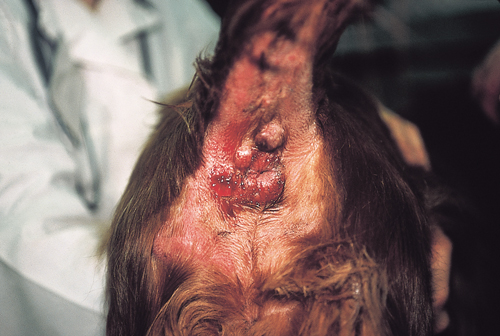Difference between revisions of "Small Animal Dermatology Q&A 21"
Ggaitskell (talk | contribs) (Created page with "{{Template:Manson Moriello}} centre|500px<br> <br /> '''A dog was presented as an after-hours emergency for the complaint of acute...") |
|||
| (One intermediate revision by one other user not shown) | |||
| Line 12: | Line 12: | ||
|a1= | |a1= | ||
Anal sac abscessation with rupture and perineal furunculosis. | Anal sac abscessation with rupture and perineal furunculosis. | ||
| − | |l1= | + | |l1=Anal Sac Abscessation |
|q2=How should the dog be treated? | |q2=How should the dog be treated? | ||
|a2= | |a2= | ||
| Line 23: | Line 23: | ||
There is the risk that damage to the anal sacs and/or ducts may lead to chronic fistulous tracts and recurrent infections. If this occurs, surgical removal of the anal sacs may be necessary. <br><br> | There is the risk that damage to the anal sacs and/or ducts may lead to chronic fistulous tracts and recurrent infections. If this occurs, surgical removal of the anal sacs may be necessary. <br><br> | ||
In this dog, the diffuse perianal furunculosis suggests that there may be an underlying pruritic trigger. Surgical excision may resolve the infections, but relapses of perianal furunculosis and inflammation will persist unless the underlying cause is found. | In this dog, the diffuse perianal furunculosis suggests that there may be an underlying pruritic trigger. Surgical excision may resolve the infections, but relapses of perianal furunculosis and inflammation will persist unless the underlying cause is found. | ||
| − | |l2= | + | |l2=Anal Sac Abscessation#Treatment |
|q3=What is the source of secretions of the anal sac and what is its function? | |q3=What is the source of secretions of the anal sac and what is its function? | ||
|a3=The walls of the sac are comprised of sebaceous glands and the ducts are lined with numerous epitrichial sweat glands. The anal sac fluid is a mixture of fatty acids, serous secretions, and cellular debris. <br><br> | |a3=The walls of the sac are comprised of sebaceous glands and the ducts are lined with numerous epitrichial sweat glands. The anal sac fluid is a mixture of fatty acids, serous secretions, and cellular debris. <br><br> | ||
The function is unknown but is presumed to be part of scent marking/social function. | The function is unknown but is presumed to be part of scent marking/social function. | ||
| − | |l3= | + | |l3=Anus - Anatomy & Physiology#Species Differences |
</FlashCard> | </FlashCard> | ||
Latest revision as of 13:20, 1 September 2011
| This question was provided by Manson Publishing as part of the OVAL Project. See more small animal dermatological questions |
A dog was presented as an after-hours emergency for the complaint of acute rectal bleeding. Note the perianal furunculosis, erythema, and exudation. After sedation, fistulous tracts were found 1–2 cm lateral to the anus in positions between 6 and 8 o’clock.
| Question | Answer | Article | |
| What is the diagnosis? | Anal sac abscessation with rupture and perineal furunculosis. |
Link to Article | |
| How should the dog be treated? | This is a chronic problem due to extensive perianal furunculosis and cellulitis.
There is the risk that damage to the anal sacs and/or ducts may lead to chronic fistulous tracts and recurrent infections. If this occurs, surgical removal of the anal sacs may be necessary. |
Link to Article | |
| What is the source of secretions of the anal sac and what is its function? | The walls of the sac are comprised of sebaceous glands and the ducts are lined with numerous epitrichial sweat glands. The anal sac fluid is a mixture of fatty acids, serous secretions, and cellular debris. The function is unknown but is presumed to be part of scent marking/social function. |
Link to Article | |
